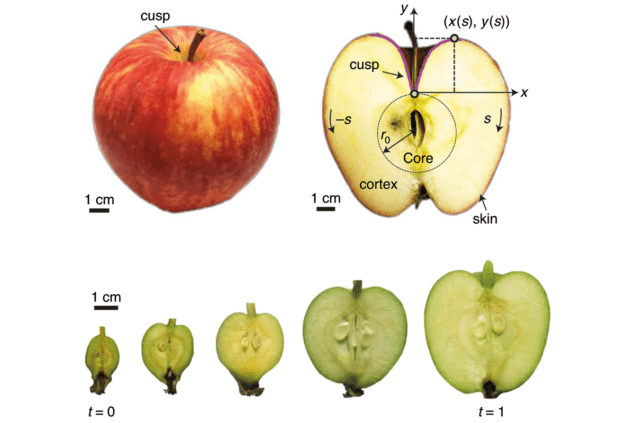 Lakshminarayanan Mahadevan and colleagues at Harvard University explore the singularity created by the abrupt change in the orientation of the apple’s surface at the base of its stalk. In a paper published in Nature Physics, they describe how this singularity develops as the apple grows from a slight bulge in the stem of a blossom into a fully-formed fruit with a seed-containing core, a fleshy cortex surrounding it and a tough outer skin.
Lakshminarayanan Mahadevan and colleagues at Harvard University explore the singularity created by the abrupt change in the orientation of the apple’s surface at the base of its stalk. In a paper published in Nature Physics, they describe how this singularity develops as the apple grows from a slight bulge in the stem of a blossom into a fully-formed fruit with a seed-containing core, a fleshy cortex surrounding it and a tough outer skin.
To make their observations, Mahadevan and colleagues began by studying the shapes of 100 apples picked at different stages of their growth from the orchard of a college, Peterhouse, at Cambridge University, UK. By slicing each apple in half, they created a series of cross-sections, then arranged them in order as if they were stills from a film depicting the changing shape of a single apple.
The team found that apples measuring less than about 1.5 cm across displayed no discernible cusp, while those with a diameter of more than 3 cm had a distinctive dip at the base of the stalk. This is because in the early stages of the apple’s growth, the contour of the peel varies smoothly. As the cortex starts to expand more quickly than the core, however, a bulge forms away from the core and a discontinuity appears in the apple’s perimeter.
Harvesting data
Next, the researchers analysed the apple’s shape by defining its cross-sectional profile as a one-dimensional curve with a height that depends on both the distance from the stalk and the size of the apple. After generating Taylor expansions of the height and distance variables in terms of the size, they succeeded in expressing the apple’s profile in a self-similar way.
To establish whether real apples also display this self-similarity while approaching a cusp-like singularity, Mahadevan and co-workers rescaled the height and stalk-distance axes using appropriate coefficients and then plotted each apple’s profile. They found, as expected, that the measured profiles all overlapped with one another near the cusp – tracing out what they describe as a “universal curve”.
The researchers went on to confirm this self-similar scaling in three ways. First, they carried out a dynamical analysis on an expanding sphere with its growth restricted at the centre but constant further away. Next, they created a mechanical simulation that treats apples as neo-Hookean materials, meaning their stress-strain curves plateau as they grow. Lastly, they performed experiments using artificial apples made from polymer spheres that swelled when immersed in hexane. By using a second, un-swellable polymer to represent the stalk, they found that a cusp formed within an hour of immersion in the solvent.
On the cusp of greatness
As a final step, the researchers investigated apples with multiple cusps, each of which creates a separate groove on the fruit’s upper surface. Using simulations, they showed that the quantity of cusps depends both on the number of carpels – that is, the apple blossom’s seed-bearing structures – and the ratio of the apple’s diameter to the diameter of its stalk. They confirmed this diameter-ratio dependence in further experiments with the polymer spheres, and they claim that it is also present in their data from real apples.

Metamaterial sculpts heart-shaped darkness from light
Mahadevan says that the research was prompted by simple curiosity, rather than any practical end. But he argues that by quantifying apple growth, he and his colleagues have sharpened some outstanding questions – including why the region near the stalk grows more slowly and what biochemical processes are involved. “This will hopefully give us a still deeper view of how nature works,” he says.
Jens Eggers of Bristol University in the UK is enthusiastic about the research but questions whether the Harvard models fully agree with the field data. In particular, he says, it is not completely clear whether the results from real apples show a correlation between cusp number and diameter ratio.
But, he adds, extracting quantitative, testable results from biological data is not easy. “By this measure the paper is doing quite well,” he says.
